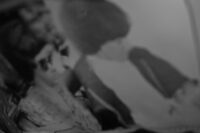
Eliza Hutchison, Family Photos and the fallibility of memory
11.2.20
Australian artist Eliza Hutchison has been commissioned to create a new series for PHOTO 2020 as the inaugural Photographer in Residence at the Parliament of Victoria. This position provides unique access to Parliament while it is sitting, and the resulting work will be presented as a public artwork at PHOTO 2020 International Festival of Photography.
To celebrate this commission, we are sharing work from Hutchison’s publication Family Photos that makes visible the turbulence of the psychological and the uncertainty and fallibility of memory. The text below is an extract from the essay 'Throes of recall, depths of love' by Dan Rule, originally published in Family Photos.
Eliza Hutchison, from the series Family Photos, 2017
Eliza Hutchison, from the series Family Photos, 2017
Photography has long been uncomfortable with its very nature as a recording device. The same tangible connection to the subject that affords the photographic medium and process its singular charge – its requisite proximity and contact with its referent, and the direct inscription of light on celluloid or sensor – also presents its great anxiety.
The choices, decisions and subjectivities of the frame are interpreted as both photography’s art and its fallibility as an index or evidentiary document. Through the lens, our experience of people, places and objects in time is underwritten by an active and ever-present acknowledgement of the storytelling devices at play. So acutely aware are we of the form that any attempt to represent or invoke the real is given a wide-ranging exit clause – the challenge too great. We makeimages after all; we don’t simply takethem. We piece together traces of the real in order to fill in the evocative, disembodied chapters of a story of our own making.
It is telling that Hutchison – who, in her early years, studied psychology and sculpture before turning to photography – has described her photographic practice in terms of “reconstructed memory”. In a sense, her work might be framed as an attempt to re-visualise the images, sensations and memories lost with her family albums. But these are not photographs as we know them. Instilled with the pliability, instability, non-linearity of the psychological, Hutchison’s images lurk illusively amidst fragments of poignant recollections, abstractions, in-camera effect and sculptural affect.
The great difficulty in ascribing photography the role of memorial device is that our memories are fluid and unfixed. Personal recall is only made solid by a conglomeration of support structures and materials. Family albums, shared stories and established narratives all work to formalise and afford memories an acceptable semblance. They allow something that is inherently slippery to become stable and dogmatic. They are an artifice.
Concurrently to documentary photography’s crisis of identity, the ocean of digital and semi-automated images that have come to define the present setting (courtesy of the iPhone, CCTV, dash cam, Google Street View and Google Earth) have permeated our lives in ways barely imagined. With multiplicity and semiconsciousness has come a different, fragmented manner of indexical legitimacy – one we seem more willing to accept than the consciously photographic. We assume veracity amid ever-billowing clouds of images.
But there is a clear conceit to both these positions. In each, we tend to deny our own subjectivities, cognitive tics, associations and psychological patterns to instead reach a kind of narrative consensus. The plasticity of visual language is reduced to the building blocks of storyline or evidence.
Dan Rule is a publisher, writer and editor from Melbourne, Australia. He is the co-director of Perimeter Books, Perimeter Distribution and Perimeter Editions, for which he has published, edited and written for upward of 50 books on contemporary photographers and artists from around the world. He has published more than 3000 articles, reviews and interviews on art, photography, design and culture more widely for international publications and institutions.